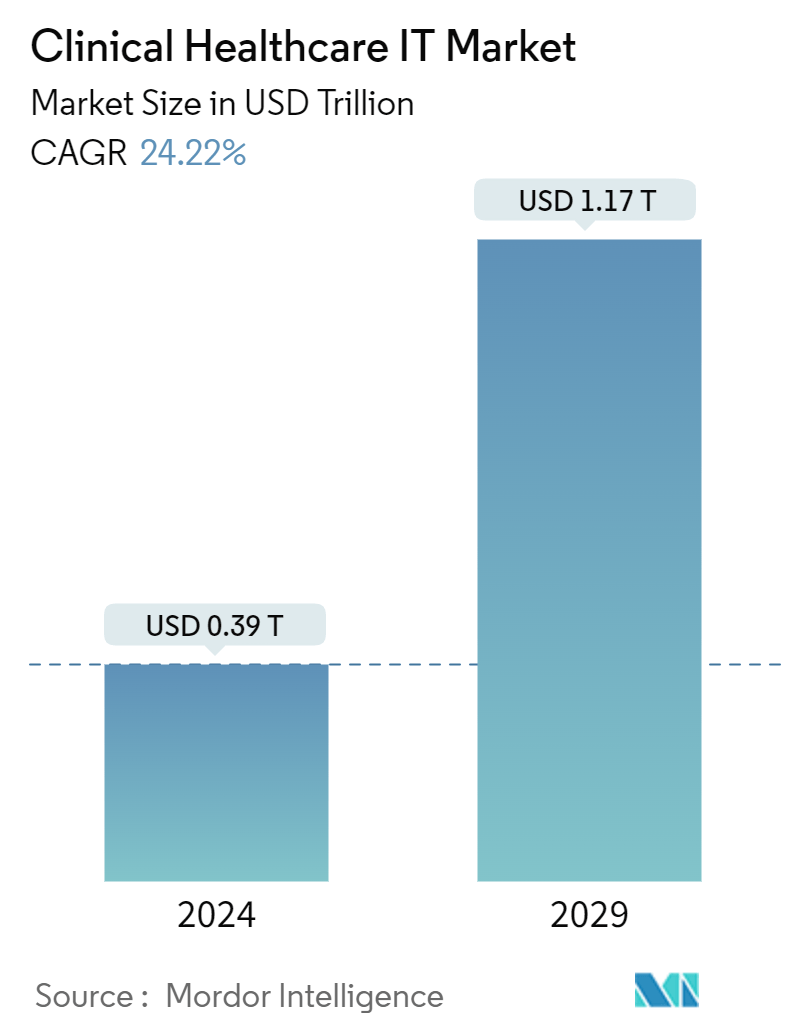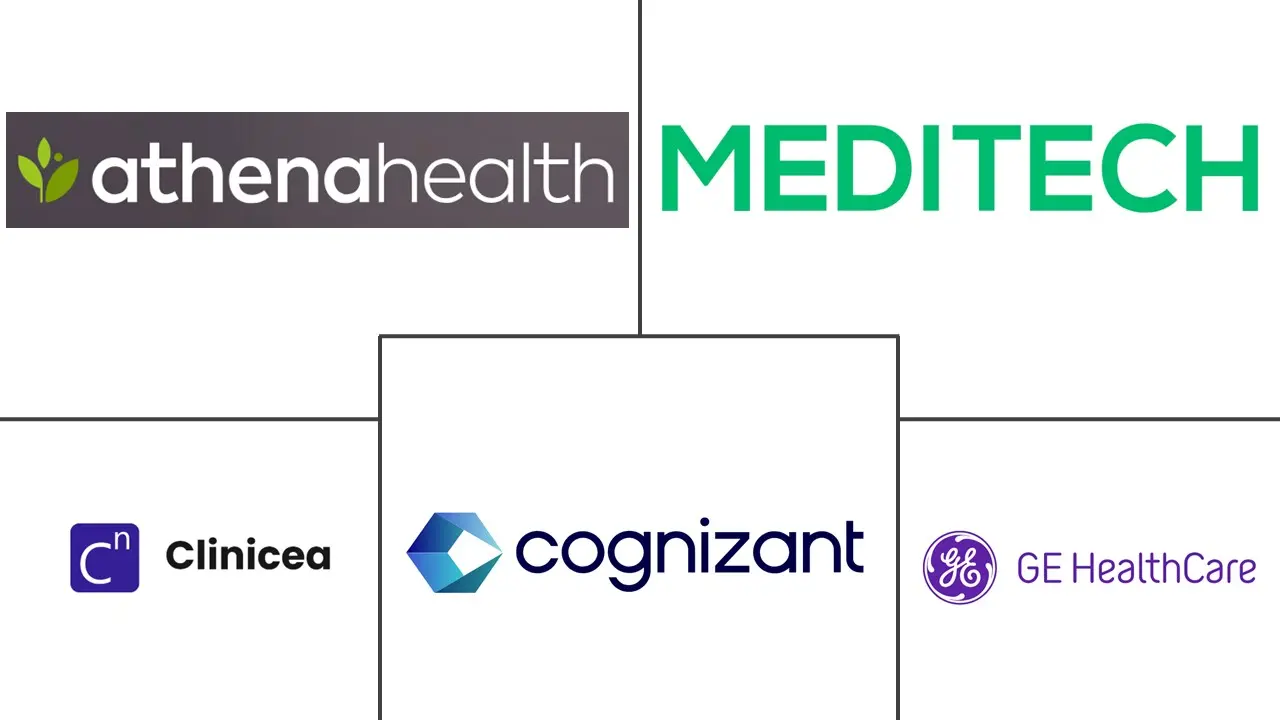Market Size of Clinical Healthcare IT Industry

| Study Period | 2019 - 2029 |
| Market Size (2024) | USD 0.39 Trillion |
| Market Size (2029) | USD 1.17 Trillion |
| CAGR (2024 - 2029) | 24.22 % |
| Fastest Growing Market | North America |
| Largest Market | Asia Pacific |
| Market Concentration | Low |
Major Players
*Disclaimer: Major Players sorted in no particular order |
Clinical Healthcare IT Market Analysis
The Clinical Healthcare IT Market size is estimated at USD 0.39 trillion in 2024, and is expected to reach USD 1.17 trillion by 2029, growing at a CAGR of 24.22% during the forecast period (2024-2029).
- Over the past few years, the healthcare sector has faced numerous challenges, including the worldwide digital transformation, the COVID-19 pandemic, significant demographic shifts, and growing patient demands. According to Morgan Stanley, the costs dedicated to artificial intelligence and machine learning in the healthcare sector are expected to surpass around 10.5% in 2024, up from 5.5% in 2022. AI in healthcare can benefit almost everything, from communication with patients to assisting with surgeries and creating new pharmaceuticals.
- The National Library of Medicine stated that around 75% of hospitals offered mobile app access, indicating mHealth’s growing role in medicine. With over 96,000 mobile health (mHealth) apps available on major Google Play and AppStore platforms, their variety is vast, including telehealth apps. According to the American Telemedicine Association, around 76% of US hospitals connect with patients and consult practitioners using video and other technology.
- Connected digital tools play a significant role in connected care by assisting patients and providers in streamlining the care continuum. Digital therapeutics, disease screening, patient education/training, and care navigation can be improved using digital tools. Wearable devices can now monitor a patient’s vitals (blood pressure, A1C, etc.) in real time and send readings to a patient’s provider. Further, GenAI can provide efficiency benefits for insurers in billing management and operations, and GenAI chatbots can produce human-like interactions for patients in healthcare customer service tasks.
- One of the biggest challenges of technology in healthcare is interoperability. As part of federal healthcare mandates, organizations must be able to keep patient data secure while also sharing it quickly with care teams.
Clinical Healthcare IT Industry Segmentation
The scope of the study focuses on the market analysis of clinical healthcare IT around the world. The market size encompasses the revenue generated through clinical healthcare IT solutions offered by various market players. The study also tracks the key market parameters, underlying growth influencers, and major vendors operating in the market, supporting market estimations and growth rates over the forecast period.
The clinical healthcare IT market is segmented by software type (electronic health records, lab information management system (LIMS), telemedicine and telehealth, picture archiving and communication software (PACS), computerized provider order entry (CPOE) and other software), end user (government and public health and private hospitals and diagnostic centers), and geography (North America, Europe, Asia-Pacific, Latin America, and the Middle East and Africa). The market sizes and forecasts are provided in terms of value (USD) for all the above segments.
| By Software | |
| Electronic Health Records | |
| Lab Information Management System (LIMS) | |
| Telemedicine and Telehealth | |
| Picture Archiving and Communication Software (PACS) | |
| Computerized Provider Order Entry (CPOE) | |
| Others (Billing, Patient Portals, and E-prescriptions) |
| By End-user | |
| Government and Public Health | |
| Private Hospitals and Diagnostic Centers |
| By Geography*** | ||||||
| ||||||
| ||||||
| ||||||
| Australia and New Zealand | ||||||
| ||||||
|
Clinical Healthcare IT Market Size Summary
The clinical healthcare IT market is poised for significant growth, driven by the ongoing digital transformation in the healthcare sector. This transformation has been accelerated by challenges such as the COVID-19 pandemic, which shifted care from high-cost settings to more accessible, technology-driven solutions like telehealth and home-based services. The integration of advanced technologies such as artificial intelligence, machine learning, and the Internet of Medical Things (IoMT) is enhancing patient care and operational efficiency. Electronic Health Records (EHR) systems are central to this evolution, providing a centralized repository for patient data and improving interoperability, which is crucial for better patient outcomes. The adoption of mobile health applications and connected digital tools is further streamlining the care continuum, enabling real-time monitoring and improved patient-provider communication.
The market landscape is characterized by intense competition and fragmentation, with numerous players vying for market share through innovation and strategic collaborations. Companies like GE Healthcare, Athenahealth, and NextGen Healthcare are at the forefront, leveraging partnerships and technological advancements to enhance their offerings. The Asia-Pacific region, particularly countries like India, South Korea, and Singapore, is experiencing rapid technological adoption, supported by government initiatives and investments in digital health infrastructure. These developments are expected to drive demand for clinical healthcare IT solutions, as stakeholders seek to improve healthcare delivery and patient outcomes through digital transformation.
Clinical Healthcare IT Market Size - Table of Contents
-
1. MARKET INSIGHTS
-
1.1 Market Overview
-
1.2 Industry Attractiveness - Porter's Five Forces Analysis
-
1.2.1 Bargaining Power of Buyers/Consumers
-
1.2.2 Bargaining Power of Suppliers
-
1.2.3 Threat of New Entrants
-
1.2.4 Threat of Substitute
-
1.2.5 Intensity of Competitive Rivalry
-
-
1.3 Industry Ecosystem Analysis
-
1.4 Insights on the regulatory landscape
-
1.5 Assessment of macro-economic scenarios and trends
-
-
2. MARKET SEGMENTATION
-
2.1 By Software
-
2.1.1 Electronic Health Records
-
2.1.2 Lab Information Management System (LIMS)
-
2.1.3 Telemedicine and Telehealth
-
2.1.4 Picture Archiving and Communication Software (PACS)
-
2.1.5 Computerized Provider Order Entry (CPOE)
-
2.1.6 Others (Billing, Patient Portals, and E-prescriptions)
-
-
2.2 By End-user
-
2.2.1 Government and Public Health
-
2.2.2 Private Hospitals and Diagnostic Centers
-
-
2.3 By Geography***
-
2.3.1 North America
-
2.3.1.1 United States
-
2.3.1.2 Canada
-
-
2.3.2 Europe
-
2.3.2.1 Germany
-
2.3.2.2 United Kingdom
-
2.3.2.3 France
-
2.3.2.4 Italy
-
-
2.3.3 Asia
-
2.3.3.1 China
-
2.3.3.2 Japan
-
2.3.3.3 India
-
2.3.3.4 South Korea
-
-
2.3.4 Australia and New Zealand
-
2.3.5 Latin America
-
2.3.5.1 Brazil
-
2.3.5.2 Argentina
-
2.3.5.3 Mexico
-
-
2.3.6 Middle East and Africa
-
2.3.6.1 United Arab Emirates
-
2.3.6.2 Saudi Arabia
-
2.3.6.3 South Africa
-
-
-
Clinical Healthcare IT Market Size FAQs
How big is the Clinical Healthcare IT Market?
The Clinical Healthcare IT Market size is expected to reach USD 0.39 trillion in 2024 and grow at a CAGR of 24.22% to reach USD 1.17 trillion by 2029.
What is the current Clinical Healthcare IT Market size?
In 2024, the Clinical Healthcare IT Market size is expected to reach USD 0.39 trillion.

